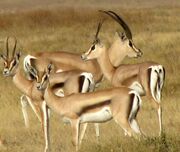
Grant's gazelles
The progression from which a species arises from a common genus is speciation. On the other hand the formation of a subspecies comes from a common species. A subspecies can be identified by the fact that they still have many common characteristics shared and can still breed with each other. This seems easy in theory to understand the different terminology but when it is applied in the field, that is quite a different story.
Grant’s gazelles subspecies identification[]
Subspecies identification can be quite problematic. Take for instance the grant's gazelles (Nanger granti). They can be found in the plains of the Sudan, Ethiopia and Tanzania. Taxonomy within this species has been confused because of the large variation in the coat color as well as horn shape. This particular group has undergone some serious debate because even though 9 subspecies had been identified some research argued that they were indistinct in the field.
A genetics study done in 2008 revealed there to be 3 geographic populations in Kenya that were acknowledged as the subspecies but were now regarded as a separate species because of the long separations between clades. The flaw in this research was that they did not describe the morphological features of the specimens which meant that there was not enough evidence to substantiate their claims.
Therefore a new study was conducted and published in 2013 where Grant’s gazelles were examined using morphological and molecular methods. The morphological analysis included horn shape and coat color and comparing these to the original 9 subspecies identification research done. The molecular test was conducted by taking a DNA sample from the bone powder of the horn. The new research revealed inconsistencies amongst their samples and that of previous studies. The taxonomic inconsistencies shows unclear diagnostic characters of subspecies which is due to insufficient information on morphological variations and not enough comparisons to type species (Nozomi & Sin-Ichiro, 2013).
Nozomi, K., & Sin-Ichiro, K. (2013). Inconsistencies Between Morphological and Genetic Subspecies of Grant's Gazelle (Nanger granti). Asian Journal Of Animal & Veterinary Advances, 8(4), 683-690. doi:10.3923/ajava.2013.683.690
Platypus example[]
The platypus plays an important evolutionary linking role, many interesting studies have been conducted to compare their likeness to other species.
They possess qualities that are both reptilian and mammalian including laying eggs but also producing milk from mammary glands (Hrdličková, Nehyba, Lim, Grützner & Bose, 2012). Currently they are on the IUCN-listed as of “least concern,” in terms of conservation efforts but their unique characteristics and specific habitat preferences point to the fact that this species should not be overlooked since they are very vulnerable to climate change (Ashwell, 2012). They are endemic to freshwater ecosystems of Eastern Australia with a predominate tendency to feed on aquatic invertebrates, a dependency on riparian habitats and a limited ability to travel overland, which makes them susceptible to a host of climate change related problems (Klamt, Thompson & Davis, 2011). The significance of this species is why ongoing research in the field to determine if there is a subspecies of the platypus is espescially important.
Probing Platypus Evolution-0
Platypus subspecies?
Ashwell, K. (2012). Development of the spinal cord and peripheral nervous system in platypus (Ornithorhynchus anatinus) and short-beaked echidna (Tachyglossus aculeatus). Somatosensory & Motor Research, 29(1), 13-27. doi:10.3109/08990220.2012.662185
Hrdličková, R., Nehyba, J., Lim, S., Grützner, F., & Bose, H. (2012). Insights into the evolution of mammalian telomerase: platypus TERT shares similarities with genes of birds and other reptiles and localizes on sex chromosomes. BMC Genomics, 13216. doi:10.1186/1471-2164-13-216
Klamt, M., Thompson, R., & Davis, J. (2011). Early response of the platypus to climate warming. Global Change Biology, 17(10), 3011-3018. doi:10.1111/j.1365-2486.2011.02472.x